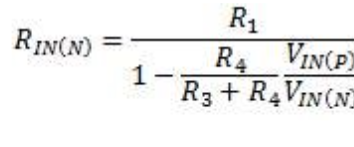Since this question is high up on google searches, I think an answer that fleshes out Andy aka's (correct) answer with the corresponding theory that explains the intuition and simulations could be helpful. Also, I think the answer to the question
I have also seen many other variations for what the input impedance of the differential amplifier on the inverting side and I'm lost. Who is correct?
is "everyone" - because the input impedance people are calculating is all correct but mean different things.
First, let's start with the way the link https://e2e.ti.com/blogs_/archives/b/precisionhub/posts/overlooking-the-obvious-the-input-impedance-of-a-difference-amplifier does it (top image below)

simulate this circuit – Schematic created using CircuitLab
With inputs V1 and V2, you get the currents
$$i_2=\frac{V_2}{R_1+R_2}\\i_1 = \frac{1}{R_1}\left(v_1-v_2\frac{R_2}{R_1+R_2}\right)$$
The resistance at V2 is easy, but the apparent resistance (R=V/I) at V1 is a truly a function of V2. That is correct and reality, if you set up that circuit with some power supplies you can measure that and validate it. However, in practice, we don't use different amplifiers in that way, and that analysis is kind of difficult to think about and do on practical signals. What we really care about is what happens to signals that are differences (which is the wanted signal, V2-V1), and what happens to signals that are common mode (which are commonly unwanted noise, (V1+V2)/2). So we just define some new voltages and currents:
$$V_d = V_2-V_1\\ V_{cm} = \frac{V_1+V_2}{2} \\ i_d = \frac{i_2-i_1}{2} \\ i_{cm} = i_1+i_2$$
Which means:
$$V_2 = V_{cm}+V_d/2 \\ V_1 = V_{cm}-V_d/2 \\ i_2 = i_{cm}/2+i_d \\ i_1 = i_{cm}/2-i_d $$
That gives us the bottom schematic in the figure above. The conventions for currents and voltages are chosen so that power is consistent (you can verify that):
$$P_{cm}+P_d = P_1+P_2 = V_{cm}i_{cm}+V_d i_d = V_1 i_1 + V_2 i_2$$
Now we can find what the differential and common mode impedances are (i.e., what does each of those signals "see" as the impedance in the amplifier) $$Z_{cm} =V_{cm}/I_{cm} \\ Z_d = V_d/I_d $$
Substituting our new terms in to our previous solution:
$$i_d = \frac{i_2-i_1}{2} = \frac{V_d}{2R_1}\\
Z_d = 2 R_1$$
which is consistent with Andy aka's answer and intuition. For the common-mode solution:
$$i_{cm} = i_2+i_1 = V_{cm} \frac{2 }{R_1+R_2}-V_d\frac{R_2/R_1}{R_1+R_2}$$
Which gives us:
$$ Z_{cm} = \frac{ \frac{R_1+R_2}{2}}{ 1-\frac{V_d}{V_{cm}}\frac{R_2}{R_1}}$$
which, again, is a bit complicated looking, but also is reality. Changing Vd can make Vcm's impedance apparently infinity. But that number also isn't necessarily that meaningful since differential impedance is what the signal would ultimately "feel" when given a Vd (what's the change in voltage per some change in current given Vd?).
$$\frac{\partial V_{cm}}{\partial i_{cm}} = \frac{R_1+R_2}{2}$$
That's the impedance the common mode source sees. Which is the same as if the common mode source was terminated by two parallel (R1+R2) to ground (which is Andy aka's answer as well).
So the answer to the question "who is right?" is basically "everyone," they're all just answering different questions. Thinking about the problem as the impedance the differential signal sees (the thing we care about) compared to the impedance the common mode signal sees (the part of the signal we typically try to eliminate in a difference amplifier) is probably more appropriate for most practical signals, and gives us a nice simple expression. However, as you can see, these impedances aren't that high - so in the end, most applications that really care about input impedances will just use an instrumentation amplifier anyway.






